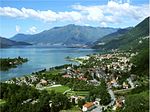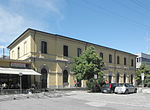Mera (Lake Como)
Commons category link is locally definedGraubünden geography stubsInternational rivers of EuropeItaly river stubsProvince of Sondrio geography stubs ... and 9 more
Rivers of GraubündenRivers of ItalyRivers of LombardyRivers of SwitzerlandRivers of the Province of ComoRivers of the Province of SondrioSwitzerland river stubsTributaries of Lake ComoVal Bregaglia

The Mera (Lombard: Maira) is a river in Switzerland and Italy. Its source is near the Piz Mungiroi, in the Grisons, Switzerland. First, it flows east in the direction to Maloja Pass, then turns west through the Val Bregaglia (German: Bergell) and crosses the border to Italy in Castasegna (Dogana). It is joined by the Acquafraggia close to Piuro, and then turns south at Chiavenna, just before it receives the river Liro from the right at Prata Camportaccio. The Mera ends in Lake Como, near Sorico in the Province of Como.
Excerpt from the Wikipedia article Mera (Lake Como) (License: CC BY-SA 3.0, Authors, Images).Mera (Lake Como)
Piazza Risorgimento,
Geographical coordinates (GPS) Address Nearby Places Show on map
Geographical coordinates (GPS)
| Latitude | Longitude |
|---|---|
| N 46.1668 ° | E 9.3751 ° |
Address
Gera Lario
Piazza Risorgimento
22010
Lombardy, Italy
Open on Google Maps








